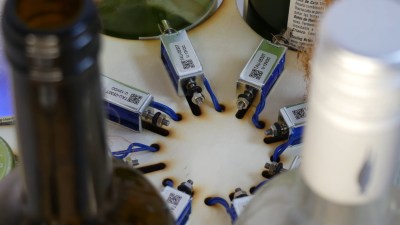If you have an iota of musicality, you’ve no doubt noticed that you can play music using glass bottles, especially if you have several of different sizes and fill them with varying levels of water. But what if you wanted to accompany yourself on the bottles? Well, then you’d need to build a bottle-playing robot.
 First, [Jens Maker Adventures] wrote a song and condensed it down to eight notes. With a whole lot of tinkling with a butter knife against their collection of wine and other bottles, [Jens] was able to figure out the lowest note for a given bottle by filing it with water, and the highest note by emptying it out.
First, [Jens Maker Adventures] wrote a song and condensed it down to eight notes. With a whole lot of tinkling with a butter knife against their collection of wine and other bottles, [Jens] was able to figure out the lowest note for a given bottle by filing it with water, and the highest note by emptying it out.
With the bottle notes selected, the original plan was to strike the bottles with sticks. As it turned out, 9g servos weren’t up to the task, so he went with solenoids instead. Using Boxes.py, he was able to parameterize a just-right bottle holder to allow for arranging the bottles in a circle and striking them from the inside, all while hiding the Arduino and the solenoid driver board. Be sure to check it out after the break.
Don’t have a bunch of bottles lying around? You can use an Arduino to play the glasses.
















Glad you knew servos wouldn’t work. The solenoids are being used backwards, maybe the first type used were pull only but these can strike when pulsed. Though these may not move past energized state to strike and get pulled back, the use of a short pulse will work. The strikers should not rest on the glass, labels will also shorten sustain. Many chimes use solenoids with the overshoot to handle coupled keyboard playing of sustained notes on organ.
Thanks for your thoughts :)
I do think servos could actually work! They do give out quite the show, but you have to calculate and correct for the variable delay to build up enough speed to strike a bottle and they take way more space…
You’re right about the reversed solenoids and the labels and their effect on the sustain of the sound. Though I enjoyed the look of the labels so I kept them. Resting the solenoids on the glass makes it very easy to calibrate the position of the solenoid respective to the bottle as compared to using them the “correct way”. They just always have to be touching the glass and it works. There is a lot of play in the construction so this makes calibration way easier. The dampening of the bottle by the solenoid head this causes turned out to be negligible, luckily :)
It is the other way around: an empty bottle gives the lowest sound.
Anyway thanks for the great article!
When I saw the headline, I was expecting a wind instrument. Surprise!
I’d love to see a compare-and-contrast to see if different kinds of bottles had different timbres, the way that wood does.